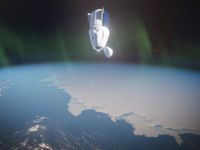In a groundbreaking advancement in robotic technology, scientists at the Russian University of Science and Technology have unveiled a spherical robot designed for exploration. This innovative robot, capable of traversing various environments, can glide effortlessly across water surfaces and transform into a small aircraft, paving the way for a new era of discovery.
The research team has developed advanced artificial intelligence systems that allow the robot to be used as a drone or controlled remotely. According to Yuri Karavaev, one of the scientists involved in the study, the robot has been trained on sophisticated control mechanisms, which have been integrated into a single device. "The robot is distinguished by its exceptional ability to perform multiple tasks and navigate various terrains," he stated.
Weighing between 200 and 300 grams, the robot is engineered to carry its own weight, making it suitable for transporting materials for various exploratory missions. Researchers anticipate that the size of the robot may be adjusted according to specific exploration tasks and the environments it is designed to navigate.
Meanwhile, in a separate but equally exciting development, SpaceX has launched its first-ever polar mission, known as "Fram 2," which orbits between the Earth's poles. This historic mission, which began in late March 2025, is led by Chun Wang, a Maltese entrepreneur and founder of a cryptocurrency mining company.
The mission's crew consists of four astronauts from diverse professional backgrounds, including Norwegian filmmaker Jannicke Mikkelsen, German roboticist Rabea Rogge—who is the first German woman to travel to space—and Australian adventurer Eric Philips. The team is set to conduct 22 scientific experiments focused on the effects of space weather and microgravity on the human body, as part of ongoing efforts to understand the challenges of long-duration space flights.
Although Elon Musk, the American businessman and founder of SpaceX, did not participate directly in the mission, his name was prominently featured throughout the event, particularly due to the marketing synergy between his various ventures. The crew arrived at the launch site in a convoy of Tesla electric cars, showcasing the integration of Musk's brands.
On the launch pad, the Falcon 9 rockets stood tall, renowned for their efficiency and reliability, while the Crew Dragon spacecraft awaited to host the astronauts during their journey. This private mission marks the sixth of its kind executed by SpaceX under its commercial spaceflight program, reflecting the company's growing influence in the global space market and opening new doors for revenue and investment opportunities.
Despite the excitement surrounding the mission, access remains limited to a select group of affluent individuals, with ticket prices reaching approximately $55 million per seat. SpaceX aims to make such journeys more reliable and accessible for those seeking a unique experience of viewing Earth from a perspective only available to satellites and space telescopes.
On the third day of the space journey, Wang shared his unique experiences with his followers on the social media platform X, emphasizing that he does not belong to the elite class of professional astronauts. He described the launch experience, stating, "The journey to orbit was smoother than I expected, except for the last minute before the engines stopped; I barely felt any loss of gravitational force. In fact, it felt like a regular flight."
He further explained, "I had imagined the launch would feel like a sudden drop in an elevator, but that sensation never occurred. I think being securely strapped into our seats made the transition to weightlessness less pronounced." However, the initial hours in microgravity were challenging, as he noted, "We all experienced space motion sickness, felt nauseous, and vomited multiple times. The sensation was different from seasickness or car sickness; we could use our iPads without worsening symptoms. But even a small sip of water was enough to upset our stomachs and induce vomiting."
Wang mentioned that no one on the crew opened the dome window on the first day, as they were all preoccupied with adjusting to the effects of microgravity. They organized a movie night to watch the recording of their launch before retiring early for the night, which turned out to be restful for everyone.
By the morning of the second day, Wang reported significant improvement, stating, "The effects of space motion sickness had completely disappeared. We had breakfast, performed some X-ray checks, and opened the dome window for three minutes after midnight GMT while flying over the South Pole."
As the rest of the crew continued to share daily moments and details of their experience with followers, they prepared for their return to Earth, which was scheduled for April 4, 2025, with a live broadcast on YouTube and X.
The Fram 2 mission signifies a remarkable step forward in the realm of human space exploration, combining innovative technology and diverse expertise to tackle the complexities of space travel. Meanwhile, the advancements in robotic exploration represent an exciting frontier for scientific discovery, promising new insights into environments previously thought unreachable.



